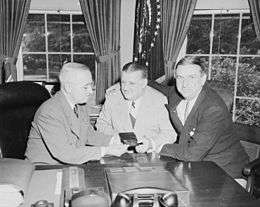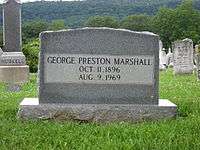George Preston Marshall
George Preston Marshall (October 11, 1896 – August 9, 1969) was an American businessman and the founder of the Washington Redskins of the National Football League (NFL). He served as their owner from 1932 until his death in 1969.[1] Marshall was the last NFL owner to integrate African-American players onto a roster, doing so in 1962 under pressure from the federal government, which threatened to block the use of the stadium that sat on federal land.
 Marshall (right) with US President Harry Truman and NFL Commissioner Bert Bell (center) in the White House (1949) | |
| Born: | October 11, 1896 Grafton, West Virginia, U.S. |
|---|---|
| Died: | August 9, 1969 (aged 72) Washington, D.C. |
| Career information | |
| Position(s) | Owner, Founder, Administrator |
| College | Randolph-Macon |
| Career history | |
| As coach | |
| 1925–1928 | Washington Palace Five |
| As owner | |
| 1932–1969 | Boston/Washington Redskins |
| Career highlights and awards | |
Life and career
Marshall was born in Grafton, West Virginia. His parents were Thomas Hildebrand ("Hill") Marshall and Blanche Preston Marshall. In 1925, while he was the owner of a chain of laundries in Washington, DC, founded by his father, he owned the Washington Palace Five basketball team, also known as the Palace Five Laundrymen from his laundry chain.[2] The team folded in 1928.
In 1932, he and three other partners were awarded an NFL franchise for Boston. The team became known as the Boston Braves, as it played on the same field as baseball's Boston Braves. Marshall's partners left the team after one season, leaving him in control. In 1933, he moved the team from Braves Field to Fenway Park, which the team would share with the Red Sox, hiring coach "Lone Star" William Henry Dietz, who may have been part Sioux and changing the team nickname to the Redskins. There were four [3] on the original Redskins team in 1933.[4] However, he claimed in an interview at the time that the name had no connection to the heritage of any player or coach.[5]
The 1936 team won the Eastern division and hosted the NFL championship game, which Marshall moved from Boston to the Polo Grounds in New York City.[6][7] Days later, he announced he was moving the team to Washington, DC, for the 1937 season.[8][9] He was romantically tied to silent screen actress Louise Brooks throughout the 1920s and 1930s, and she gave him the nickname "Wet Wash" because he owned the laundry chain. He was married to film actress-author Corinne Griffith from 1936 to 1958. She referred to him in print as "The Marshall without a plan."
Although his team enjoyed great success, Marshall is known more for many of the frills that now mark the modern football game. During the early days of the NFL, college football was more popular. Marshall decided to incorporate elements of the college atmosphere into the professional league. Innovations that he introduced include gala halftime shows, a marching band, and a fight song. The Redskins marching band is currently one of only two officially sanctioned by any NFL team. The fight song "Hail to the Redskins" is one of the most famous in the NFL. Marshall, along with George Halas, successfully suggested two major rules changes that were designed to open up the game and increase scoring. One was to allow a forward pass to be thrown from anywhere behind the line of scrimmage, rather than at a minimum of five yards behind the line. Another was the move of the goal posts from the end line to the goal line, where they have been in Canadian football, to encourage the kicking of field goals. The change remained in place for about four decades until NFL goal posts were returned to the end line in the mid-1970s as part of an effort to lessen the influence on the game of kicking specialists. Upon obtaining the team in 1932, Marshall also pushed to standardize the schedule so that each team played the same number of games, the teams were split into divisions with the winners meeting in a championship game, and game gate receipts were split between the home team and the visitor using by either a 60–40 split or a guaranteed amount of money, whichever was larger.[10]
Marshall did many things to try to endear the team to the people of Washington. During the 1937 season, Marshall rented a train and brought 10,000 fans to New York City to watch the team play the New York Giants. The actions paid off, and even today, Redskins fans are considered among the league's most loyal and some of the most likely to travel in large numbers to away games.
In the 1950s, Marshall was the first NFL owner to embrace the new medium of television. He initiated the first network appearances for any NFL team and built a huge television network to broadcast Redskins games across the South.
Marshall was a very hands-on owner. For most of his tenure as the team's owner, he frequently micromanaged the team. The notable exception was during the Flaherty era, the franchise's first successful era.

Marshall suffered a debilitating stroke in 1963, soon after his induction to the Pro Football Hall of Fame.
He died at his Georgetown home in Washington in August 1969,[1] and his funeral was held at the National Cathedral in Washington with a huge crowd in attendance. Marshall is buried at the family plot in Indian Mound Cemetery in Romney, West Virginia.[11]
Legacy
His legacy includes the George Preston Marshall Foundation, which serves the interests of children in the Washington metro area.
Racism
Marshall is noted for his opposition to having African-Americans on his roster.[12] The league previously had a sprinkling of black players, but they had been excluded from all NFL teams in 1933. The rest of the league began signing individual black players in 1946 and drafting them by the 1950s, but Marshall was the final owner to sign a black player, which he attributed to a desire to appeal to Southern markets as the team was the southernmost team in the NFL until the Dallas Cowboys joined in 1960.[13] Marshall once said that he would begin doing so when the Harlem Globetrotters started playing white players. His refusal to integrate was routinely mocked in Washington Post columns by writer Shirley Povich, who sarcastically used terms from the Civil Rights Movement and related court cases to describe games: for instance, he once wrote that Jim Brown "integrated" the end zone, making the score "separate but unequal."
In 1962, Secretary of the Interior Stewart Udall and Attorney General Robert F. Kennedy issued an ultimatum that unless Marshall signed a black player, the government would revoke the Redskins' 30-year lease on D.C. Stadium (now RFK Memorial Stadium), which had been paid for by government money and was owned by the city government.[14] Marshall's chief response was to make Ernie Davis, Syracuse University's All-American running back, his top draft choice in the 1962 NFL Draft. However, Davis refused to play under him and demanded a trade which the team granted, sending to the Cleveland Browns for All-Pro Bobby Mitchell.[15] Mitchell was the first African-American to play a game for the Redskins, and he played with the team from 1962 to 1969 initially at running back but later making his biggest impact at wide receiver. Mitchell was inducted into the Pro Football Hall of Fame in 1983. In June 2020, a statue of Marshall was removed from the grounds of RFK Stadium after it was defaced and vandalized following the George Floyd protests.[16][17] The same month, he was removed from the Redskins Ring of Fame at Fedex Field.[18]
References
- "Grid figure Marshall dies at 72". Reading Eagle. Pennsylvania. Associated Press. August 10, 1969. p. 57.
- ESPN
- Indians
- "Why did the Washington Redskins choose the name "Redskins" in the first place, rather than some other Native American name?". Marquette University Law School Faculty Blog.
- https://www.youtube.com/watch?v=uCoHuyAv0kY
- "Play-off game is definitely set at Polo Grounds". Milwaukee Journal. December 7, 1936. p. 6, part 2.
- "Bays, Boston play for crown in N.Y. Sunday". Milwaukee Sentinel. Associated Press. December 8, 1936. p. 14.
- "Capital gets Boston team". Milwaukee Journal. Associated Press. December 17, 1936. p. 8, part 2.
- McGrath, John (January 10, 2006). "Redskins history lesson". Lakeland Ledger. Florida. McClatchy News Service. p. C1.
- Roberts, Howard (1953). "The Magnificent Marshall". The Story of Pro Football. Rand McNally & Company. pp. 196–197. LCN 53-9336.
- "Funeral services for Washington's Marshall today". Spartanburg Herald. South Carolina. Associated Press. August 13, 1969. p. 17.
- Outside the Lines: African Americans and the Integration of the National Football League, by Charles K. Ross, New York: New York University Press, 1999, ISBN 0-8147-7495-4.
- Yardley, Jonathan (September 2, 2011). "'Showdown: JFK and the Integration of the Washington Redskins,' by Thomas Smith". The Washington Post.
- https://www.npr.org/2011/09/04/140066378/a-showdown-that-changed-footballs-racial-history
- http://www.nfl.com/news/story/09000d5d80b75df1/article/ernie-davis-legacy-lives-on-long-after-his-death
- https://dcist.com/story/20/06/19/monument-for-washington-football-teams-racist-founder-removed-from-rfk-stadium-after-being-defaced/
- "Protesters in Washington pull down confederate statue after day of demonstrations and celebration on Juneteenth". Kyle Swenson, Emily Davies, Patricia Sullivan, Samantha Schmidt, Perry Stein, Justin William Moyer, Marissa J. Lang, Lauren Lumpkin, Frederick Kunkle, Paul Duggan, Petula Dvorak, Clarence Williams. 20 June 2020. Archived from the original on 20 June 2020.
- Keim, John. "Redskins removing name of former owner George Preston Marshall from Ring of Fame". ESPN. Retrieved 24 June 2020.